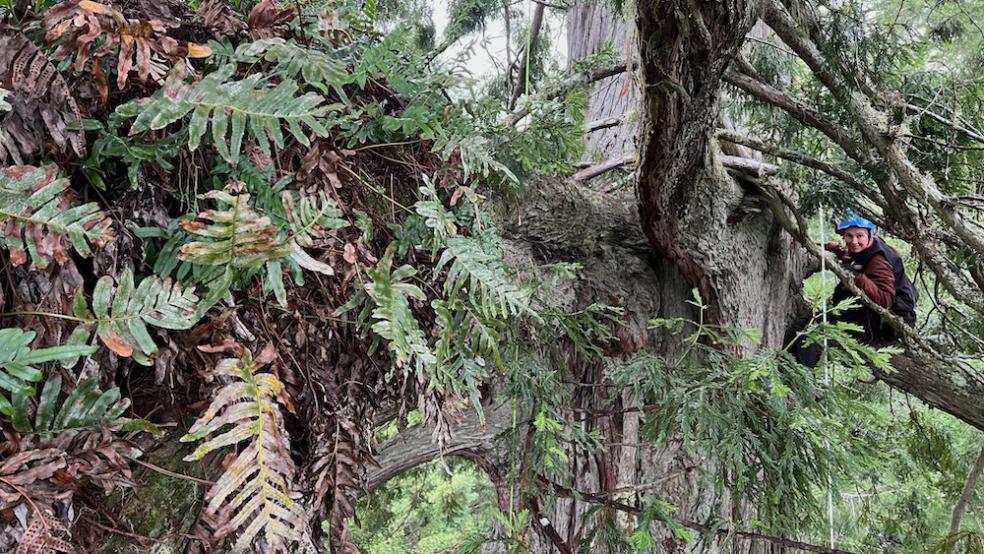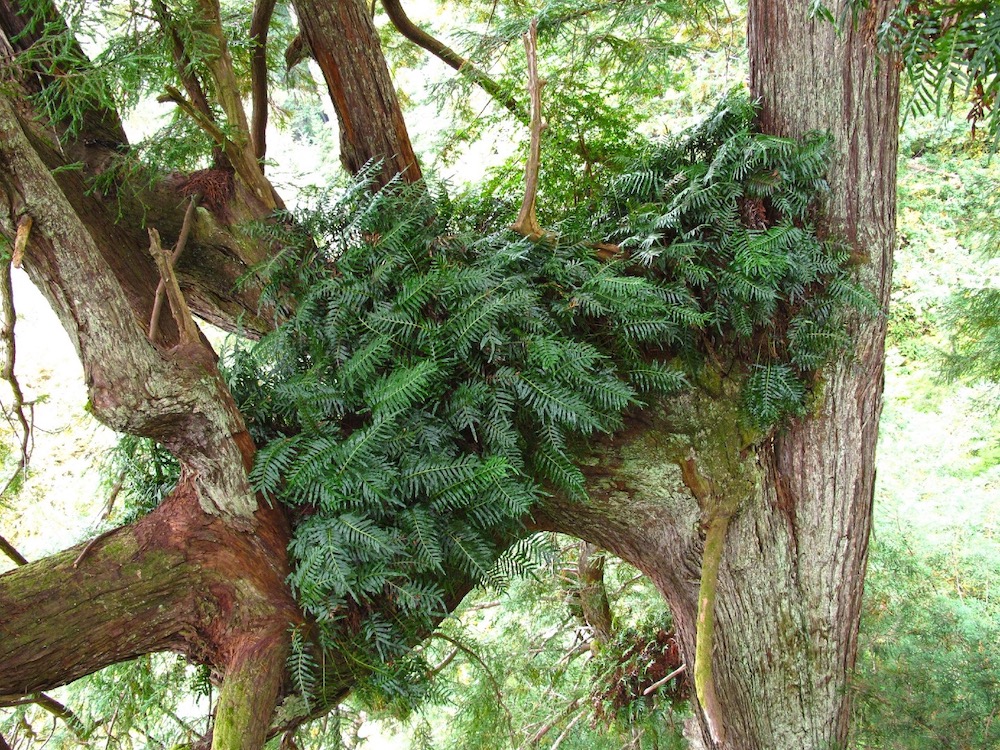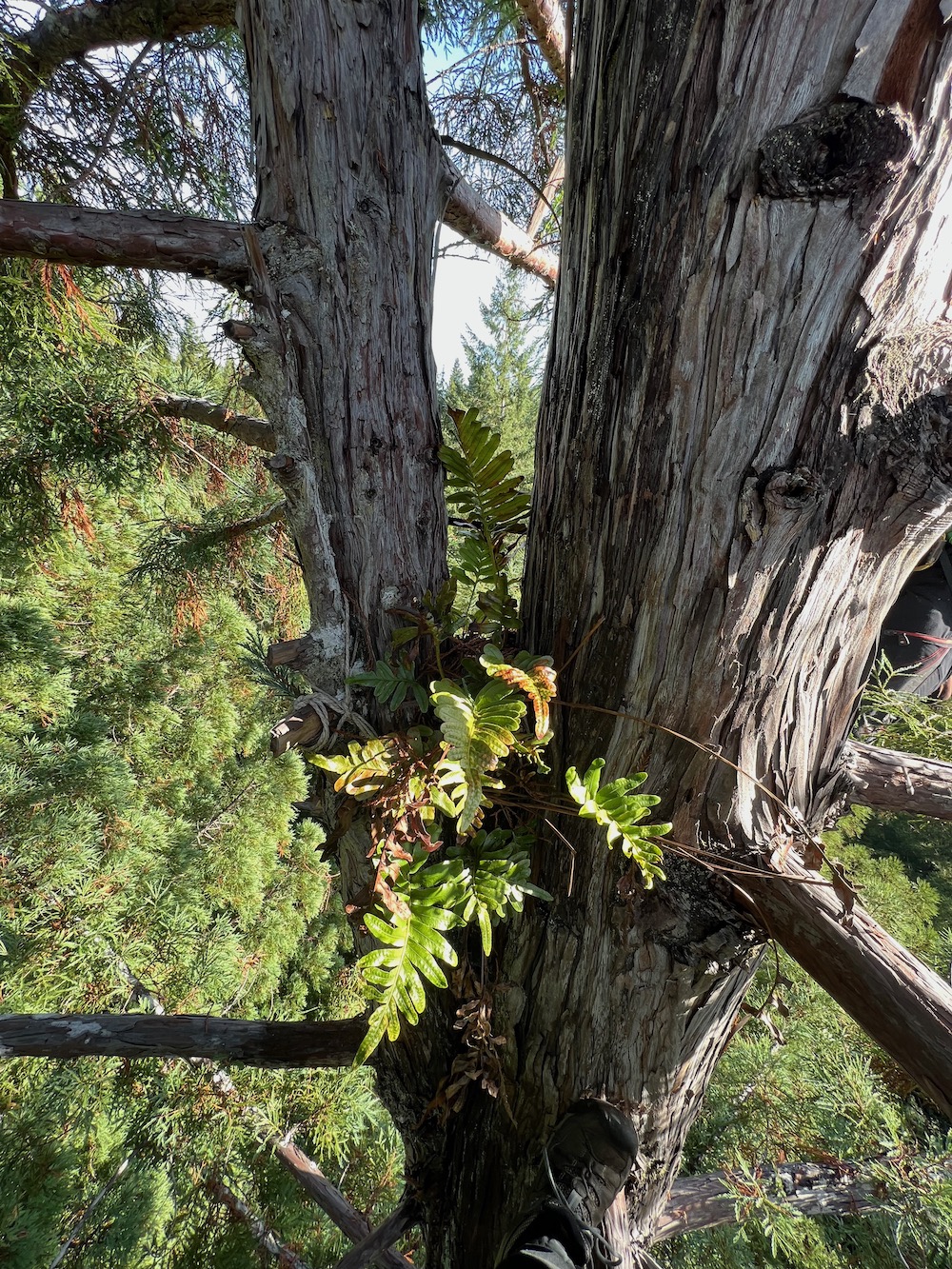
Redwoods, the world’s tallest trees, can host an entire food web in their crowns with plants, small animals, and more. These biodiversity hotspots are exclusively found in primary or old-growth forests—of which only 5% remain—in the wettest part of the redwood range. Two Cal Poly Humboldt faculty are on a mission to restore canopy ecosystems in regenerating or secondary redwood forest.
A keystone species in the redwood canopy is Polypodium scouleri, or leather-leaf fern. These ferns, along with the decomposed organic matter that makes up the soil in which they grow, form fern mats. Mats can grow to be 8 feet wide and hold nearly 5,000 gallons of water per acre each year. This ability to collect and hold water may be key to redwood canopy biodiversity success and survival in a warming and drying climate.
Cal Poly Humboldt Professor Stephen Sillett and research associate Marie Antoine, both Forestry faculty, have embarked on a project that could help re-establish fern mats in redwood canopies and boost biodiversity by successfully transplanting ferns mats from primary to secondary redwood forests.
Since 2021, they have worked with the Pacific Forest Trust and botanist and wildlife biologist Giacomo Renzullo (‘00, Biological Sciences) to introduce the fern mats to certain trees in the van Eck forest in Fieldbrook, just east of McKinleyville.
Sillett was among the first to discover these fern mats in the mid-90s when he and his students climbed into the canopies of local primary redwood forests, says Antoine. “These early endeavors revealed an ecosystem that was new to scientific description—giant fern mats, arboreal shrub thickets, wandering salamanders—these organisms were familiar in the redwood forest terrestrial community, but the canopy was largely unexplored until then.”
Over centuries, the fern mats become enormous, she adds. “We’ve measured mats the size of cars with thousands of fronds and soil layers over a meter deep. This is only possible because redwoods are so long-lived, thanks to their extremely decay-resistant heartwood and their fire resilience.”
The mats are rich in biodiversity. Their soil captures and slowly releases water, buffering canopy microclimate, says Antoine. Seeds from plants, including Western hemlock and huckleberry shrubs, take root and grow in the arboreal soil, providing berries for birds and small mammals. Mats also provide habitat for insects like spiders, centipedes, and crickets, which become food for larger animals like birds and the wandering salamander.

Only the largest and oldest trees in the forest host fern mats, which means that relatively few giant, elder redwoods play an outsized role in supporting canopy biodiversity.
Of the 235 redwood trees they studied in a recent rangewide analysis, only 34 had ferns and other vascular plants living in their crowns, and their average age was over 1,100 years, she says.
“Elder Trees were relatively rare on the landscape to begin with, and there’s little provision for such trees in the future,” she adds. “This is why we suggest designating some trees in regenerating forests as Potential Elder Trees (PETs).”
Designated PETs—some of the most robust trees in secondary forests—would be excluded from future harvest plans, instead providing valuable biodiversity and long-term carbon sequestration over the course of their lives. For redwoods, that could be more than 2,000 years, says Antoine.
Due to their size and longevity, the researchers hypothesize that PETs could make great homes for fern mats, boosting biodiversity in secondary redwood forests. To test this idea, they’ve introduced 60 fern mats back into the crowns of 11 PETs in the van Eck forest.
Transplanting these mats requires the researchers to collect material that has fallen to the ground after winter storms in local primary forests. They then cultivate the mats until they’re roughly the size of a loaf of bread. Once ready, they carry the mats up into the crown of a PET in bags hung from their feet as they climb. After identifying a promising transplant site, they tie the ferns onto crevices in the trees using thick hemp cord. Over time, the researchers document the fern mats, tracking features such as frond size and survival.

“Using intact fern mats (versus sprinkling fern spores) jump-starts the process of fern establishment and accelerates the return of ecosystem services to the young forest canopy,” Antoine explains.
Nearly three years into the study, the researchers are learning what works and what doesn’t. Many of the ferns are making new fronds, and many of these fronds are already producing spores.
Such success shows that restoring canopy ecosystems in regenerating redwood forests is possible. “While this is a small effort, it’s satisfying and hopeful work,” she says.
The researchers hope to expand this work into local regenerating forests with slightly older trees, such as the Arcata Community Forest behind the University’s campus.